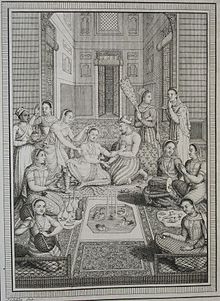Mir Jumla II | |
|---|---|
 | |
| 14th Grand Vizier of the Mughal Empire | |
| In office April 1656 – 1657 | |
| Badshah | Aurangzeb |
| Preceded by | Saadullah Khan |
| Succeeded by | Jafar Khan |
| 23rd Subahdar of Bengal | |
| In office 9 May 1660 – 30 March 1663 | |
| Badshah | Aurangzeb |
| Preceded by | Shah Shuja |
| Succeeded by | Shaista Khan |
| Personal details | |
| Born | 12 February 1591 Isfahan, Safavid Iran |
| Died | 30 March 1663 (aged 72) Mankachar, Ahom Kingdom |
| Children | Muhammad Amin Khan |
| Religious affiliation | Islam |
| Military service | |
| Allegiance | |
| Branch/service | Army of the Mughal Empire |
| Battles/wars | Battle of Khajwa Battle of Kaliabor |

Mir Jumla II (12 February 1591 – 30 March 1663), or Amir Jumla,[1] also known as Ardistānī Mir Muhammad,[2] was a military general, wealthy diamond trader,[3] a Vizier of Golconda sultanate,[4] and later a prominent subahdar of Bengal under the Mughal Emperor Aurangzeb.[5]
Mir Jumla is a powerful politician that played important role in northern and Peninsular region of India during the reign of Shah Jahan to Aurangzeb, where he encountered multiple european nation companies interest in India, such as Danish East India Company, East India Company, Dutch East India Company, and Portuguese East India Company.[6]
He commanded the vast merchant fleets enterprise which sailed throughout Surat, Thatta, Arakan, Ayuthya, Balasore, Aceh, Melaka, Johore, Bantam, Makassar, Ceylon, Bandar Abbas, Mecca, Jeddah, Basra, Aden, Masqat, Mocha and the Maldives.[7] The most important aspect of Mir Jumla's rule in Bengal was his northeastern frontier military campaign, by which he conquered the frontier kingdoms of Kamrup (Kamarupa) and Assam.[8]
- ^ James Talboys Wheeler (1876, p. xxx)
- ^ Cite error: The named reference
The Chronology of Modern India for Four Hundred Years from the Close of the Fifteenth Century A.D. 1494-1894; James Burgesswas invoked but never defined (see the help page). - ^ Sarkar 1951, p. 3
- ^ Gommans, Jos (2003). Mughal Warfare: Indian Frontiers and High Roads to Empire 1500–1700. Routledge. p. 78. ISBN 0-415-23988-5.
- ^ Majumdar, R.C, ed. (1974). The History and culture of the Indian People Vol 7- The Mughal Empire. Bharatiya Vidya Bhavan. pp. 475–476.
- ^ Jagadish Narayan Sarkar (1939, p. 918-949)
- ^ Cite error: The named reference
googlewas invoked but never defined (see the help page). - ^ D. Nath (January 1989). History of the Koch Kingdom, C. 1515-1615 (Hardcover). Mittal Publications. pp. 86, 225–226. ISBN 9788170991090. Retrieved 8 March 2024.